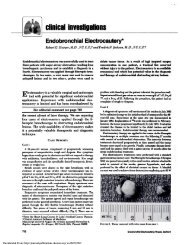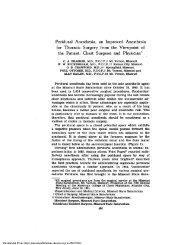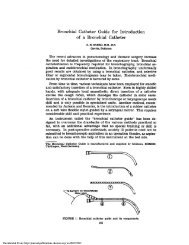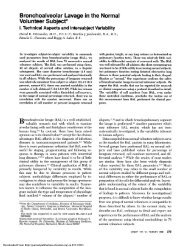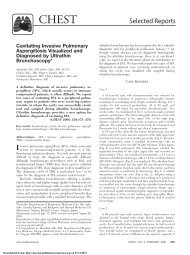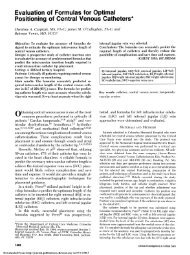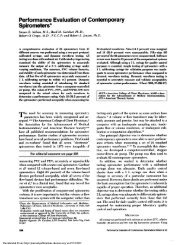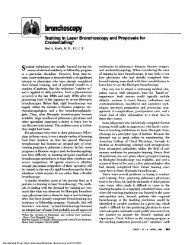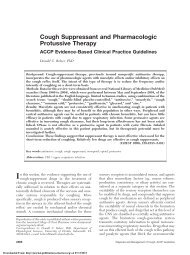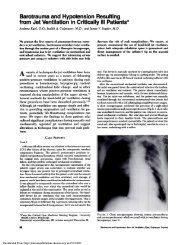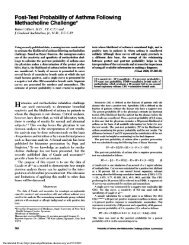Detection of Epidermal Growth Factor Receptor Mutation in ...
Detection of Epidermal Growth Factor Receptor Mutation in ...
Detection of Epidermal Growth Factor Receptor Mutation in ...
You also want an ePaper? Increase the reach of your titles
YUMPU automatically turns print PDFs into web optimized ePapers that Google loves.
Table 2—Diagnostic Yield <strong>of</strong> Different Bronchoscopic<br />
Sampl<strong>in</strong>g Techniques*<br />
TBLB<br />
TBNA<br />
Positive Negative<br />
Positive 70 (74.4) 1 (1.1)<br />
Negative 23 (24.5)<br />
*Data are presented as No. (%).<br />
one patient, and L858R was detected <strong>in</strong> seven<br />
patients. E746 A750 deletion and L858R substitution<br />
mutations were frequent (12 <strong>of</strong> 13 patients with<br />
detectable EGFR mutations; 92.3%). Figure 1 shows<br />
the results <strong>of</strong> direct sequenc<strong>in</strong>g <strong>in</strong> a patient with<br />
E746 A750del (patient 50; Fig 1, top, A), and a<br />
patient with L858R (patient 70; Fig 1, bottom, B).<br />
None <strong>of</strong> the patients had more than one mutation.<br />
<strong>Mutation</strong> Analysis Us<strong>in</strong>g the Scorpions ARMS<br />
Method<br />
We performed Scorpions ARMS <strong>in</strong> all patients.<br />
We could analyze EGFR mutation status <strong>of</strong> 91<br />
patients us<strong>in</strong>g the EGFR Scorpions kit. Because<br />
curves correspond<strong>in</strong>g to neither the wild-type nor<br />
the mutant-type were detectable <strong>in</strong> two patients, we<br />
could not determ<strong>in</strong>e their EGFR mutation status.<br />
NSCLC was diagnosed <strong>in</strong> another patient with<br />
TBLB alone. Curves corresponded to EGFR mutations<br />
<strong>in</strong> 27 patients, <strong>in</strong>dicated the E746 A750del <strong>in</strong><br />
exon 19 <strong>in</strong> 16 patients, and <strong>in</strong>dicated L858R <strong>in</strong> exon<br />
21 <strong>in</strong> 11 patients (Fig 2).<br />
Comparison <strong>of</strong> the Two Methods for Detect<strong>in</strong>g the<br />
Two Major <strong>Mutation</strong>s<br />
EGFR mutations were detected <strong>in</strong> 31 patients<br />
(Table 3). Both methods together could determ<strong>in</strong>e<br />
mutation status <strong>in</strong> 9 patients, whereas either Scorpions<br />
ARMS or direct sequenc<strong>in</strong>g could do so <strong>in</strong> 18<br />
patients and 4 patients, respectively. The EGFR<br />
mutations were more frequently detected by the<br />
Scorpions ARMS method than by direct sequenc<strong>in</strong>g<br />
(Table 4).<br />
EGFR <strong>Mutation</strong> Status and Cl<strong>in</strong>ical Manifestations<br />
The frequency <strong>of</strong> EGFR mutations was higher <strong>in</strong><br />
patients with adenocarc<strong>in</strong>omas (23 <strong>of</strong> 58 patients,<br />
39.7%; vs 8 <strong>of</strong> 36 patients, 22.2% <strong>in</strong> nonadenocarc<strong>in</strong>omas),<br />
women (14 <strong>of</strong> 31 patients, 45.2%; vs 17 <strong>of</strong> 62<br />
patients, 27.4% <strong>in</strong> males), and nonsmokers (14 <strong>of</strong> 34<br />
patients, 41.2%; vs 17 <strong>of</strong> 59 patients, 28.8% <strong>of</strong><br />
current or former smokers), although the differences<br />
were not statistically significant. The EGFR status<br />
detected by direct sequenc<strong>in</strong>g alone was not statistically<br />
correlated with cytologic diagnosis, gender, or<br />
response to gefit<strong>in</strong>ib (data not shown).<br />
Figure 1. Wave figures generated by direct sequenc<strong>in</strong>g. Top, A: E746 A750 del <strong>in</strong> exon 19. Bottom,<br />
B: L858R <strong>in</strong> exon 21. All mutations were confirmed bidirectionally with forward and reverse<br />
sequenc<strong>in</strong>g.<br />
www.chestjournal.org CHEST / 131 /6/JUNE, 2007 1631<br />
Downloaded From: http://journal.publications.chestnet.org/ on 12/05/2012



